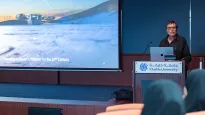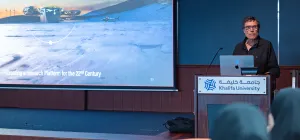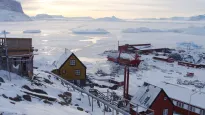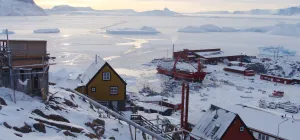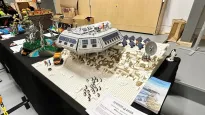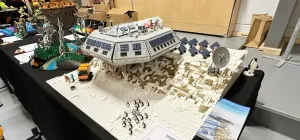A reporter’s perspective on a scientific journey

Veteran reporter Jos Van Hemelrijck recounts the memorable journey he took to the King Baudoin Ice Shelf. He spent more than a week getting a taste of what life is like for a scientist doing field research in Antarctica.
Off we go!
On Tuesday, December 9th we set out from the Princess Elisabeth station for our long awaited trip to the coast. Alain Hubert, seismologist Denis Lombardi, schoolteacher Roger Radoux and I, your veteran reporter, set off for the coast. We had news that our friends on the Derwael Ice Rise were doing really well despite heavy snowstorms that kept them shuttered in their modified container / living quarters for three days. They had finished drilling the first of two 30-metre ice cores and were 17 metres down on the second when we started out.
We were to meet with them on the King Baudouin Ice shelf in a couple of days, but first we were expected at Sismo Camp, 160 kilometres north of the Princess Elisabeth station in an area known as the “grounding line” of the ice shelf. The grounding line is the place were the glacier ice that slowly flows down from the Antarctic high plateau reaches the ocean and starts flowing out over the water on a floating platform of ice.
It took us twelve bumpy hours on our skidoos to get there. We made a stop at the former Japanese research station of Asuka. Abandoned since 1994, it had become an eerie Antarctic ghost town. The station itself has long disappeared under the snow. But the site was littered with traces of activity long ago.
We marvelled at the sight of rows of abandoned vehicles – skidoos, bulldozers and trucks – nose-diving slowly into the ice from the weight of their own engines. Much to our surprise, we spotted a sledge sporting a mast and skis. It bore an uncanny resemblance to a catamaran wrecked on a reef in a sea of ice.
But we could not linger. We had another 80 kilometres to go. It was a rough ride on our skidoos. “It's been a bad year for snow,” Alain remarked. “The surface is usually a lot smoother.”
Eight hundred metres below our feet lies the edge of the continent
Sismo Camp appeared as a black speck in a sea of white. As we approached, we could distinguish a row of bright coloured dots: the tents where we were to sleep. There was a snow tractor and two sledges: one with the lab-container; the other was loaded with fuel tanks and a 10-foot mess container.
We where welcomed by Jan Lenaerts and Christophe Berclaz. “It's good to see new faces!” said Jan. Christophe insisted we have a bite to eat before making any plans. They had arrived at this location four hours before we did.
The next day, Jan set up his automatic weather station. It will stay here until next year and transmit via satellite information about air and snow temperature, wind speed and direction, air pressure, solar radiation, snow height, etc.
Denis Lombardi, assisted by Alain and Christophe, meanwhile started to install a series of seismometers north and south of the grounding line. Each seismometer was buried inside a neat hole they had made in the snow, sitting on a glass disc, protected by a plastic cover and connected to its own solar panel to power it for months. He also brought two very precise GPS stations to keep track of the vertical and horizontal movement of the ice.
“The ice, when it reaches the ocean at the grounding line, is 800 metres to 1 kilometre thick,” explained Denis. “Where it starts floating over the water, it hinges with the ice on the bedrock of the continent. The floating ice shelf is subjected to the effects of the ocean tides. The entire ice shelf rises and sinks 1.5 metres twice every day.”
The King Baudouin Ice Shelf is stable and healthy…or is it?
By Iridium satellite phone we heard that the IceCon team had left Derwael Ice Rise to set up a new drilling camp on the King Baudouin Ice Shelf.
“When you ride on a slow-moving snow tractor over this plain of snow, you get to thinking,” glaciologist Frank Pattyn told me later, “The Baudouin Ice Shelf is about the size of a country like Belgium. It's 400 kilometres across. And this ice shelf holds back an area of ice roughly the size of Europe!”
Global warming has caused important ice shelves to disintegrate in the recent past, although mainly in West Antarctica. The flow of outlet glaciers there is speeding up at an alarming rate, contributing to a lot of ice being lost to the ocean. However, this is not the case in East Antarctica – al east not yet.
The King Baudouin Ice Shelf is typical for this part of East Antarctica. Ice here flows down to the coast at a leisurely pace of a 150 metres a year. This ice shelf seems to be stable and healthy… or is it? Frank said that this is what they are trying to figure out. He explained that a weakening of this seemingly rock solid chunk of frozen water could have dramatic consequences on sea level rise. So it's important to know if it will continue to hold back an area of ice the size of Europe for a long time into the future.
No wonder scientists from different disciplines concentrate on studying the King Baudouin Ice Shelf!
Down to work!
Frank and his assistant Brice van Liefferinge, brought a PRESS ice radar. The instrument is so sophisticated that it can measure the loss off even half a centimetre of ice down at the bottom of the ice shelf, were the warm ocean water meets the ice.
Jean-Louis Tison and Morgane Philippe want to drill strait trough the entire ice shelf to understand what happens to the ice down there.
The site of the drilling camp was picked very carefully. The average thickness of the King Baudouin Ice Shelf is 300 metres. But some spots are different. On satellite pictures, the scientists saw that several long gullies run trough the shelf from the grounding line to the sea. These gullies are not very big – only a couple of hundred metres wide and quite shallow. They are only 15 metres below the surrounding ice.
“No big deal!” I thought, until someone pointed out that 9/10ths of the ice lies below the surface og the water. This means that the shelves’ thickness here was not 300 metres, but a mere 150! Jean Louis reckoned that the drill would hit the water at that precise depth.
These mysterious gullies that seem insignificant at the surface seem to be cavernous vaults on the underside of the shelf. One hypothesis is that they funnel the warmer ocean water beneath the Baudouin Ice Shelf, weakening it from underneath.
The drill gets stuck!
At Sismo camp, Roger Radoux , the schoolteacher, took charge of preparing dinner for tonight. It was a delicious pre-cooked lamb curry with rice. Humans need fuel too. Thanks Roger!
In the morning, InBev-Baillet Latour winner Jan Lenaerts showed me how he takes firn samples from the surface layers of the ice shelf. He uses a device called a firn corer. This instrument is a hollow, hand-operated device that is slowly screwed into the snow, and can reach up to 5.5 metres deep. He cleverly fitted a cordless drill to the top so that not everything must be done by hand!
The firn cores he extracted clearly show different layers of compressed snow alternated with layers of ice. “The ice layers are proof of periods of summer melt,” Jan explained, “and once snow on the surface has melted, its albedo changes dramatically.”
The albedo is the snow surface’s capacity to reflect the sun’s energy. Once the snow has melted and refrozen, it absorbs twice as much solar energy as before. And it will continue doing that for the rest of the season.” The goal of the BENEMELT project is to find out if the King Baudouin Ice shelf is affected – as Jan suspects – by surface melt and ice loss from the surface.
The first cores seemed to prove him right. Jan began taking a series of samplings across the shelf from Sismo Camp to the drill site, 80 kilometres away.
That night, Alain told us that at Drill Camp things had gone wrong. The drill got stuck at 54.6 metres below the surface. We decided to pack up our camp a day early and go there to give them a hand.
All is lost...or is it?
Jean Louis Tison is a positive thinker. He happily showed me the ice cores he had drilled up at Derwael and here on the King Baudouin Ice Shelf in what he calls his “ ice library” - the deep-freeze container that will preserve his harvested ice samples until they reach his laboratory in the Université Libre de Bruxelles. At least all was well on that front.
But now he had to make a difficult choice: pull harder on the drill – essentially overruling all standard safety procedures for the use of the drill. Doing so would risk snapping the cable and losing the expensive drill, motor and all, 54.6 metres down in the ice. The alternative was to try a method he had never used: freeing the drill with glycol, or anti-freeze. However there was one problem: there was not near enough anti freeze available at the camp site.
Alain chimed in and announced that there was plenty at the Princess Elisabeth station. We arranged for a 200-litre barrel of antifreeze would be loaded onto a Prinoth snow tractor that same night. It would drive northward as soon as possible and rendez-vous halfway with another snow tractor that will set out from our side at Drill Camp. The arrangement would save us valuable time, which was fast running out. The scientists had only a few days before they had to pack up camp and return back to the Princess Elisabeth station so they could catch their flight back to Belgium in time for Christmas.
Glycol to the rescue!
The glycol arrived the following evening. It was not as simple as pouring it down the barrel of the drill into the bore hole. The glycol simply dispersed in the upper layers of ice without doing any good at the bottom. It needed to be diluted, too. But we put our collective heads together and found a way. We devised an antifreeze delivery contraption that made use of garden hoses, plastic pipes and gardenia couplings, all secured with duct tape and pieces of string in case anything became undone.
We pumped half a barrel of antifreeze down the hole and let it sit overnight, and crossed our fingers...
The next morning, Jean Louis applied maximum amperage to the winch’s motor. The cable vibrated, and the drill returned to us at the surface! You could see the relief on everyone's faces!
The drilling continues
Too much time was lost to reach a depth of 150 metres. That was obvious. Now the question was: Should the team not just pack up and admit defeat? It seemed the sensible thing to do.
But nothing would conquer the indefatigable spirit of the scientists in their quest for knowledge. They decided to forge ahead and drill continuously 24 hours a day in shifts.
Everybody joined in the effort. Teams where formed to relieve Jean Louis and Morgane to give them a chance to rest every now and then. Brice set up a pair of hi-fi loudspeakers on the drill site, and Kristof Soete put on his collection of Dutch tearjerkers, Heavy Metal and Punk to keep everyone's spirits up. Scientists, field guides and mechanics took turns at tweaking the controls of the drill, checking the cable, brewing coffee and marking and storing more and more sections of ice cores. This went on for a full two days and two nights.
A fruitful effort nonetheless
But unfortunately, time ran out. It eventually came time to pack up and head home for Christmas. But the team had reached a total depth of 107 metres, and the data contained in the ice cores will certainly be very valuable.
“You know what?” remarked Frank Pattyn as we boarded the convoy bound for the station. "We measured the ice every day at the same location for the entire period we were on the King Baudouin Ice Shelf. Every day, the same layers showed up until at the very end, something changed...” Frank explained.
“We have yet to analyse the data, of course, but something surely is happening down there below!”
Download
















